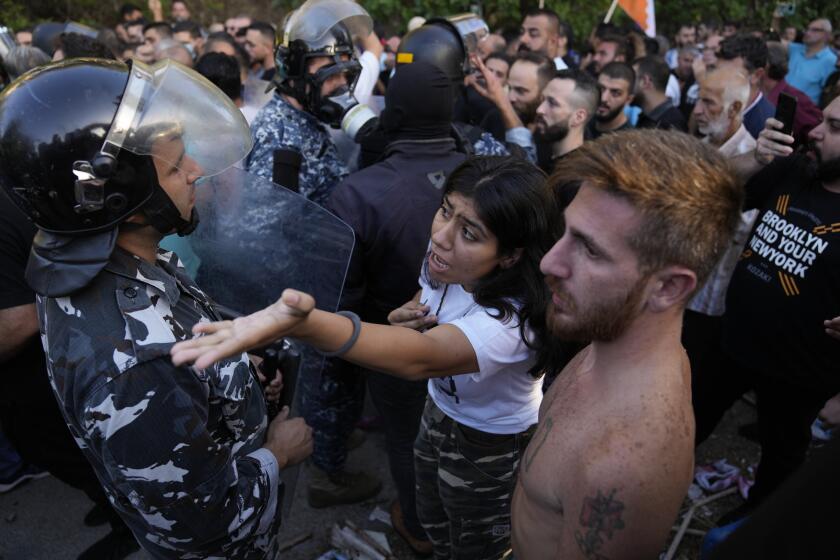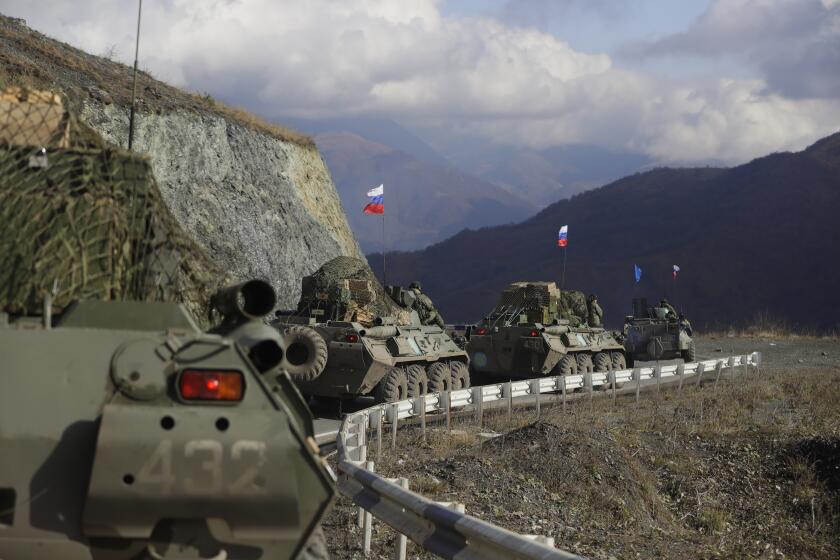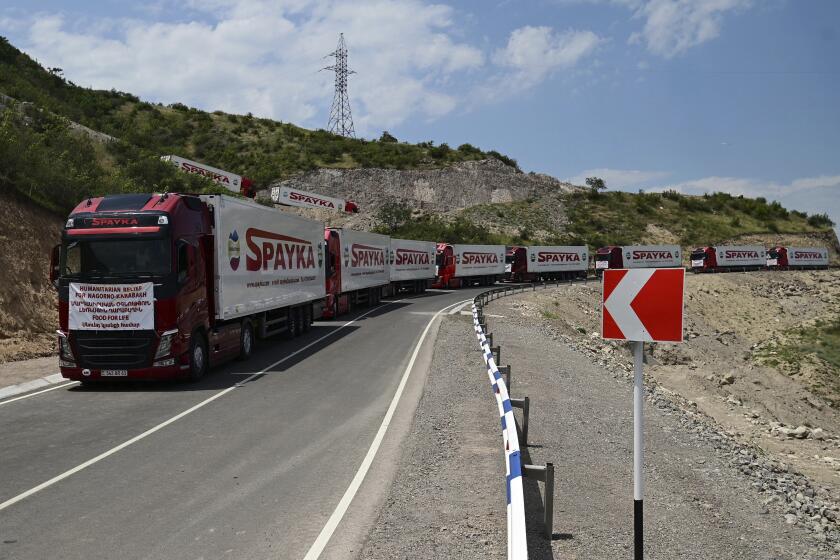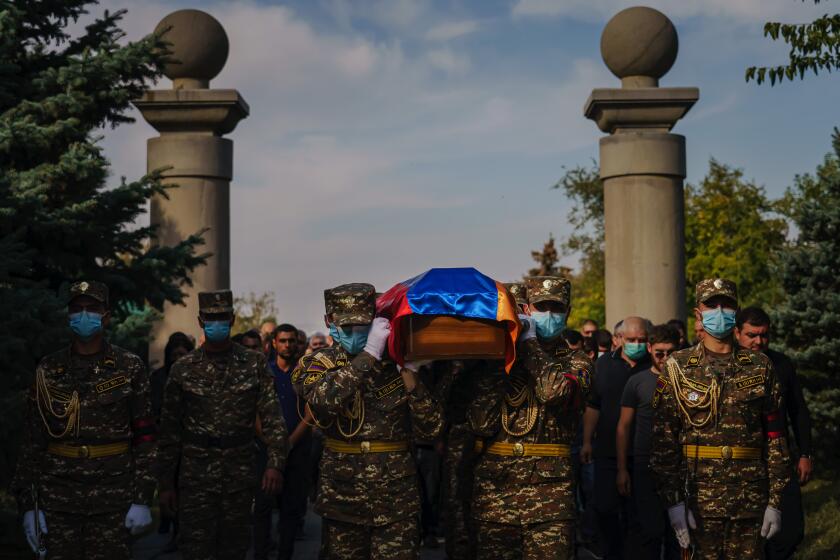Why no one should believe reports of Armenians’ ‘voluntary’ exodus from Artsakh
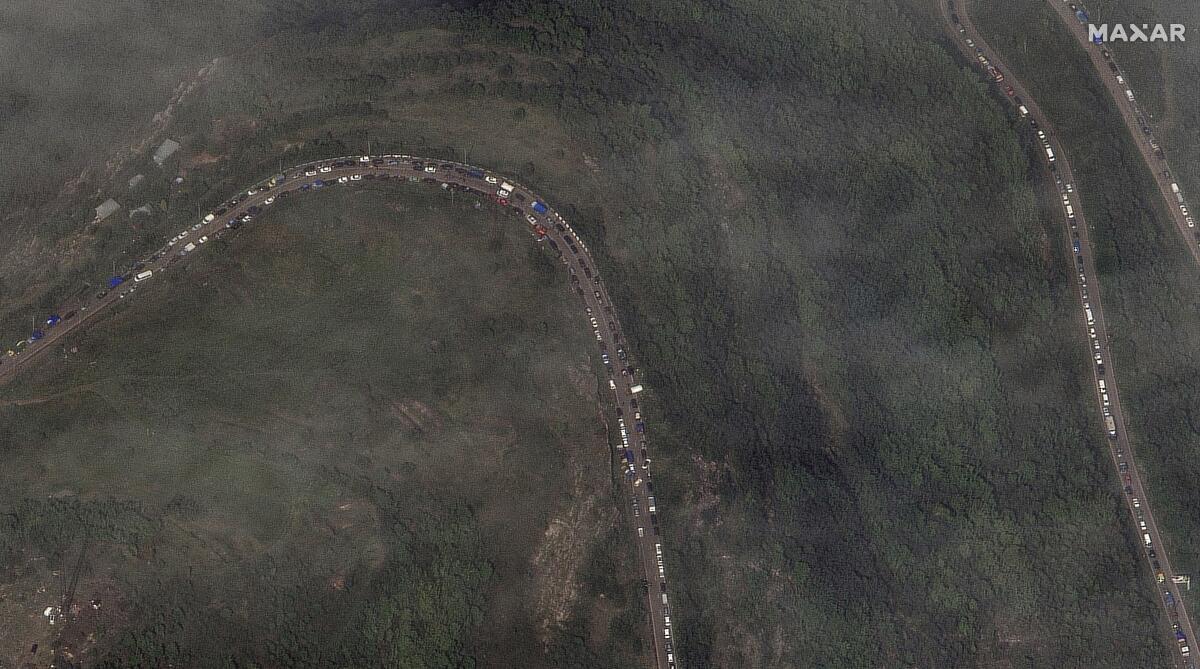
- Share via
Over the last two weeks, thousands of vehicles have lined a serpentine road stretching for three miles in the South Caucuses Mountains near the border of Armenia and Azerbaijan. At times, the multitude of cars was so dense that it could be seen from space. The travelers — refugees — survived extreme deprivation for nine months and a harrowing military assault against their homeland.
The road, known as the Lachin Corridor, is the sole escape route out of the Armenian Republic of Artsakh, also called Nagorno-Karabakh, situated on territory Azerbaijan claims is its own. As of Monday, more than 100,000 Artsakh Armenians, the Indigenous people of the region, had fled from the land their ancestors lived on for millennia. They face an uncertain future.
In 1939, Armenians of Musa Dagh fled to Lebanon rather than submit to Turkish rule. Now they despair over the exodus from Nagorno-Karabakh and Azerbaijan.
For Armenians around the globe, satellite imagery of the Lachin Corridor exodus raises a historical specter. It echoes photography documenting death marches across the Syrian desert during the 1915 Armenian genocide, proof of forcible expulsion and ethnic cleansing.
For media outlets and global actors who take their cues from Azerbaijan’s officialdom, the images tell a markedly different story. They depict not expulsion but the voluntary departure of separatists from a breakaway region who have chosen to flee, after the restoration of Azerbaijani territorial sovereignty.
How do we account for these divergent narratives and the consequences they pose for Artsakh’s Armenians? To do that requires disentangling the role that disinformation and Armenophobia play in Azerbaijan’s authoritarian regime.
The world watched and allowed a brutal genocide three decades ago in the Bosnian city of Srebrenica. A tragically similar crisis is looming again.
For decades, Azerbaijan’s state officials have openly espoused pan-Turkism, an ethnoterritorial ideology that aims to unite all Turkic-speaking peoples and that undergirds the catastrophe in Artsakh today.
In 2005, the mayor of Baku, the capital of Azerbaijan, summarized his country’s position succinctly: “Our goal is the complete elimination of Armenians.” During a 2020 military offensive in the region, Azerbaijani President Ilham Aliyev famously announced, “This is the end. … We are chasing them like dogs.”
In December 2022, according to news reports, Azerbaijanis posed as environmental protesters to initiate an illegal blockade of Artsakh, closing the Lachin Corridor. Critical shortages of food, fuel and medical resources followed. With the population on the brink of famine by August, a former International Criminal Court prosecutor warned that a “genocide by starvation” was unfolding.
The international community — including, not insignificantly, nations that have recently doubled gas imports from Azerbaijan — remained silent, and Aliyev acted with impunity. He launched a lightning offensive on Sept. 19, against malnourished civilians and civilian infrastructure under the guise of “anti-terror” measures. At least 200 died in Artsakh, with many more wounded.
Azerbaijan has been blockading crucial supplies from Armenians since December. To end this cruelty, the U.S. must apply more pressure.
Forced to surrender, Artsakh President Samvel Shahramanyan signed a decree stating that the republic would “cease to exist” on Jan. 1, 2024. In a matter of days, nearly the entire population had been forcibly displaced. For the first time in thousands of years, Artsakh is effectively absent Armenians.
Sidestepping ethnic cleansing and the humanitarian catastrophe, some news media have announced that Azerbaijan has “reclaimed” its territory and that a “smooth reintegration process” awaits Artsakh’s Armenians. What these accounts leave out is Azerbaijan’s history of disinformation, explicit expressions of genocidal intent and systematic silencing of those who oppose Aliyev’s authoritarian government.
From 2018 to 2021, reports published by the Palo Alto-based think tank Institute for the Future and the Guardian revealed a sprawling, state-sponsored digital repression campaign to obstruct political participation and block online dissent in Azerbaijan, overlapping with the country’s 2020 military offensive in Artsakh.
A major investigation by the Organized Crime and Corruption Reporting Project exposed a multibillion-dollar laundering scheme connected to the Azerbaijani state that funneled funding to public relations efforts that promote government views. Reporters Without Borders ranks Azerbaijan at 151 out of 180 countries in its 2023 World Press Freedom Index.
The defeat of Armenians last fall rips open the wound of the 1915 genocide, but I hope it doesn’t overwhelm Armenian Genocide Remembrance Day.
As Azerbaijan took Artsakh captive in September, NetBlocks cited “major disruptions to internet connectivity” in the region, obstructing the flow of information. A week later, Amnesty International reported that five Azerbaijani activists had been arrested and detained in connection with their advocacy for Artsakh’s Armenians.
The republic’s leaders, including former Artsakh state minister Ruben Vardanyan and three former presidents of the republic, have been arrested by Azerbaijani forces, in some cases as they tried to cross the border to Armenia.
Over the weekend, footage circulated of the deserted central square of Stepanakert, the Artsakh capital — strewn with abandoned chairs and possessions, a “ghost town,” in the words of one correspondent. A U.N. mission arrived Sunday, but as one refugee told the Guardian, “What is there left for the U.N. to monitor? … It is too late now.”
Despite all this, the international community remains keen to euphemize the “voluntary” exodus from Artsakh.
As scholars of media and of language, we are acutely aware of the geopolitical consequences of disinformation. The consequences will be all too grave for Artsakh’s Armenians. What looms is permanent displacement, dispossession and the erasure of their presence in the region.
There are mechanisms that might yet yield meaningful interventions. Ethnic cleansing and even genocide charges against Aliyev and his government could be brought in the International Criminal Court. Sanctions could be imposed against officials in Azerbaijan, as nearly 100 House and Senate lawmakers have urged. U.S. military assistance to Azerbaijan could be cut, and substantial international funding could be allocated to aid the refugee population streaming into Armenia.
To activate these mechanisms, the claims of Azerbaijan’s disinformation apparatus must be recognized and denied — chief among them that 100,000 Armenians have “chosen to flee” their ancestral lands. One hundred and six years lapsed before the U.S. formally acknowledged the Armenian genocide of 1915. It’s vital to recognize the genocide that’s currently underway while it is still possible to resist it.
Mashinka Firunts Hakopian is an associate professor of technology and social justice at ArtCenter College of Design. Shushan Karapetian is the director of the USC Dornsife Institute of Armenian Studies.
More to Read
A cure for the common opinion
Get thought-provoking perspectives with our weekly newsletter.
You may occasionally receive promotional content from the Los Angeles Times.
